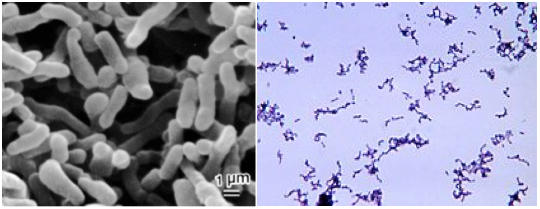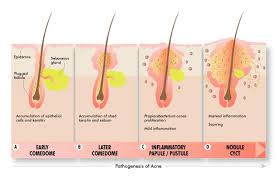Team:Montgomery Cougars NJUSA/Project/PathogenesisofAcne
From 2014hs.igem.org
(→Pathogenesis of Acne) |
(→Pathogenesis of Acne) |
||
| (7 intermediate revisions not shown) | |||
| Line 5: | Line 5: | ||
1. Blockage of sebaceous follicles. | 1. Blockage of sebaceous follicles. | ||
| + | [[Image:sebumprolif.jpg|left|250px|thumb|Sebum Buildup]] | ||
<ul> | <ul> | ||
<li>Sebaceous follicles are exocrine glands found in the skin of humans, concentrated within the facial area</li> | <li>Sebaceous follicles are exocrine glands found in the skin of humans, concentrated within the facial area</li> | ||
| Line 29: | Line 30: | ||
<br> | <br> | ||
| - | <center>[[File:acne_path.jpg| | + | <center>[[File:acne_path.jpg|center|400px|Acne Pathogenesis]]</center> |
<br> | <br> | ||
Latest revision as of 01:58, 21 June 2014
Pathogenesis of Acne
Acne Vulgaris is caused by four main factors:
1. Blockage of sebaceous follicles.
- Sebaceous follicles are exocrine glands found in the skin of humans, concentrated within the facial area
- Sebum is produced to keep the skin moisturized and acts as a the first immune system barrier
- The oils and lipids in skin build up around sebaceous follicles and irritate the emerging hair shaft
- The extreme growth and build up creates cysts and nodules that are visually unappealing and painful when irritated
2. The epithelial cells in sebaceous follicles undergo abnormal desquamation (shedding of the skin). Comedogenesis is the obstruction of sebaceous follicles due to greater cohesiveness of the follicular epithelial cells and sebum. As keratinous material gathers in the sebum filled follicle, the wall thins and swells.
- While comedogenesis is a natural process in humans, the overstimulation through androgens and other hormones contributes greatly to the proliferation of P. Acnes
- Keratinocytes actively exacerbate acne formation and sebum production
3. The anaerobic, commensual bacterium Propionibacterium acnes proliferates in a lipid rich environment, such as when there is an overproduction of sebum. Excessive sebum production is caused by androgenic stimulation of sebaceous glands.
4. P. acnes produces proinflammatory mediators that cause microcomedones to inflame and become papules, pustules, and nodulocystic lesions. A microcomedone is the precursor to acne, an accumulation inside a pore, causing the pore to be plugged by dead skin cells and sebum.
Lipases, proteases, and hyaluronidases, produced by the bacteria, act as proinflammatory products.
Acne can manifest itself on the skin in a variety of manners, from mild comedonal form to severe inflammatory cystic on the face, back, and chest. When androgen is released throughout the body, it precipitates activity in the sebaceous glands, promoting comedone and seborrhoea formation, propagating the inflammatory P. acnes. P. acnes is actually present in the pilosebaceous ducts as an anaerobe.
 "
"


